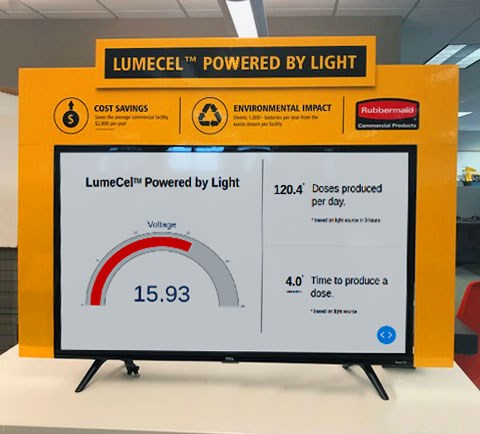

One of the benefits of having a strategic digital partner is bouncing ideas off them and finding out if something is possible, does it already exist and what would it take to pull off.
Jim Smith, Senior Marketing Communications Manager, asked us, “Is there a way to hook something up to a solar cell and see how much energy it’s producing and display on a monitor?” Our reply, “not sure, let’s figure it out.” Jim’s follow up, “Oh and by the way, we need it done by the end of next week so we can demo it with the VP.” Our response was of course, “Can do.” Working with an established partner, the logistics were not going to get in our way to move fast on this. We were able to get budget approval, coordinate overnighting of a Lumecel sample (the product that incorporates the solar cell) that same day and were exploring options the next day.
The first problem to solve was, "What off- the-shelf hardware options were available that we could connect to a power supply and display voltage?"
Based on recommendations from the lead product engineer at RCP we wanted to try a Raspberry Pi option. The Raspberry Pi (RP) is a simple put powerful minicomputer. The RP has tons of potential, touchscreen monitor, out-of-the-box sensors and peripherals available to jump start the project. Quite quickly we were able to hook the wiring from the solar cell to the RP — and with custom written Python code were reading voltage on the screen the same day. Problem one solved in two days. Now, on to the next problem.
Our next question to tackle was, “Why does it matter to anyone?” .
With a physical connection and live voltage monitoring in place we focused on the presentation and user experience. Our next question to tackle was, “Why does it matter to anyone?” Having worked with RCP for over 11 years, we’re pretty familiar with their product line. The Lumecel dispenser is an innovative evolution to bathroom hand soap dispensers. The engineering team’s goals were to reduce batteries going to landfills, eliminate the human time needed to replace these batteries, and increase the longevity of these dispensers for facilities.
The current Lumecel conference exhibit shows the amount of batteries a unit can eliminate, but ultimately doesn’t prove that it works. After brainstorming with the internal and RCP team members, we realized that we wanted the prototype to show how effective the unit is at replenishing its power, but we also needed to address the perception in the marketplace: “Does this do what you say it does?”, and “Can it realistically eliminate replacing batteries?”
We realized that since we could show how much power (voltage) different light sources produce, we could also demonstrate how that affects the wattage being stored. RCP engineering provided some key values and equations from which we could calculate (in real time) how long it would take the unit to replenish the energy required to dispense one unit of soap and how many dispenses it would be able to store based on an 8-hour day of exposure to this amount of light. With these numbers, we could demonstrate the Lumecel product’s ability to perform and the effectiveness of the solar cell design. With a quick collaboration between our UX designer and Software Engineer a user-friendly layout was created to display the concept. At this point, we’ve proved the concept, solved the presentation requirements and have a working prototype 6 business days after the initial request. Not too bad.

Time to deliver the goods
From the beginning, we knew the presentation would be in Huntersville and we’re a 6-hour drive from RCP. So, we had the RCP order the same hardware we used ahead of time to eliminate any time with shipping so they could duplicate our prototype on their end. At this point, we created an image of the Raspberry Pi operating system, our code and settings that could be loaded on their SD chip and sent a link to download them. The device image combined with our installation instructions ensured the RCP team had an identical duplicate to run and test. After some display settings changes, they had the prototype hooked up to their display monitor and were reading voltage. Success! Rapid, collaborative team and process, and a lot of fun to work on. This kind of turn around would be next to impossible to pull off with a new team. Having a digital partner allows you to move faster and provide greater value for your organization.
The concept is being evaluated for application at conferences as an effective presentation of the product’s performance and proof of claim.
Do you have an idea?
We'd be glad to discuss your idea and provide insights on how to bring it to life. Drop us a line and let us know you're interested in a FREE CONSULTATION.
Related Articles